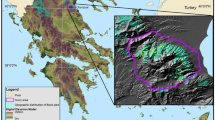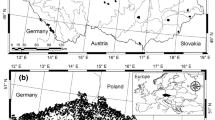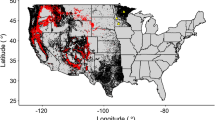Abstract
A height–diameter mixed-effects model was developed for loblolly pine (Pinus taeda L.) plantations in the southeastern US. Data were obtained from a region-wide thinning study established by the Loblolly Pine Growth and Yield Research Cooperative at Virginia Tech. The height–diameter model was based on an allometric function, which was linearized to include both fixed- and random-effects parameters. A test of regional-specific fixed-effects parameters indicated that separate equations were needed to estimate total tree heights in the Piedmont and Coastal Plain physiographic regions. The effect of sample size on the ability to estimate random-effects parameters in a new plot was analyzed. For both regions, an increase in the number of sample trees decreased the bias when the equation was applied to independent data. This investigation showed that the use of a calibrated response using one sample tree per plot makes the inclusion of additional predictor variables (e.g., stand density) unnecessary. A numerical example demonstrates the methodology used to predict random effects parameters, and thus, to estimate plot specific height–diameter relationships.



Similar content being viewed by others
References
Arabatzis AA, Burkhart HE (1992) An evaluation of sampling methods and model forms for estimating height–diameter relationships in loblolly pine plantations. For Sci 38:192–198
Avery TE, Burkhart HE (2002) Forest measurements. 5th edn. McGraw-Hill, New York
Assman E (1970) The principles of forest yield studies. Pergamon, Oxford
Baskerville GL (1972) Use of logarithmic regression in the estimation of plant biomass. Can J For Res 2:49–53
Burkhart HE, Parker RC, Strub MR, Oderwald RG (1972) Yield of old-field loblolly pine plantations. School of Forestry and Wildlife Resources, Va Polytech Institute and State University Publication FWS, pp 3–72
Burkhart HE, Cloren DC, Amateis RL (1985) Yield relationships in unthinned loblolly pine plantations on cutover, site-prepared lands. South J Appl For 9:84–91
Calama R, Montero G (2004) Interregional nonlinear height–diameter model with random coefficients for stone pine in Spain. Can J For Res 34:150–163
Castedo Dorado F, Barrio Anta M, Parresol BR, Álvarez González JG (2005) Stochastic height–diameter model for maritime pine ecoregions in Galicia (northwestern Spain). Ann For Sci 62:455–465
Eerikäinen K (2001) Stem volume models with random coefficients for Pinus kesiya in Tanzania, Zambia, and Zimbabwe. Can J For Res 31:879–888
Eerikäinen K (2003) Predicting the height–diameter pattern of planted Pinus kesiya stands in Zambia and Zimbabwe. For Ecol Manage 175:355–366
Epstein R, Nieto E, Weintraub A, Chevalier P, Gabarró J (1999) A system for the design of short term harvesting strategy. Eur J Oper Res 119:427–439
Fang Z, Bailey RL (2001) Nonlinear mixed effects modeling for slash pine dominant height growth following intensive silvicultural treatments. For Sci 47:287–300
Gregoire TG, Schabenberger O (1996a) Non-linear mixed effects modeling of cumulative bole volume with spatially correlated within-tree data. J Agri Biol Environ Stat 1:107–109
Gregoire TG, Schabenberger O (1996b) A non-linear mixed-effects model to predict cumulative bole volume of standing trees. J Appl Stat 23:257–271
Hall DB, Clutter M (2004) Multivariate multilevel nonlinear mixed effects models for timber yield predictions. Biometrics 60:16–24
Huang S, Titus SJ, Wiens DD (1992) Comparison of nonlinear height–diameter functions for major Alberta tree species. Can J For Res 22:1.297–1.304
Hui G, Gadow Kv (1993) Zur Entwicklung von Einheitshöhenkurven am Beispiel der Baumart Cunninghamia lanceolata. Allg Forst Jagdztg 164:218–220
Jayaraman K, Zakrzewski WT (2001) Practical approaches to calibrating height–diameter relationships for natural maple stand in Ontario. For Ecol Manage 148:169–177
Laird NM, Ware JH (1982) Random-effects models for longitudinal data. Biometrics 38:963–974
Lappi J (1986) Mixed linear models for analyzing and predicting stem form variation of Scots pine. Commun Inst For Fenn 134:1–69
Lappi J (1991) Calibration of height and volume equations with random parameters. For Sci 37:781–801
Lappi J, Bailey RL (1988) A height prediction model with random stand and tree parameters: an alternative to traditional site index methods. For Sci 34:907–927
Littell RC, Milliken GA, Stroup WW, Wolfinger RD (1996) SAS® System for mixed models. SAS Institute Inc., Cary
López Sánchez CA, Gorgoso Varela J, Castedo Dorado F, Rojo Alboreceda R, Rodriguez Soalleiro R, Alvarez Gonzalez JG, Sanchez Rodriguez F (2003) A height–diameter model for Pinus radiata D, Don in Galicia (Northwest Spain). Ann For Sci 60:237–345
Lynch T, Murphy P (1995) A compatible height prediction and projection system for individual trees in natural, even-aged shortleaf pine stands. For Sci 41:194–209
Lynch TB, Holley AG, Stevenson DJ (2005) A random-parameter height-dbh model for cherrybark oak. South J Appl For 29:22–26
Martin F, Flewelling J (1998) Evaluation of tree height prediction models for stand inventory. West J Appl For 13:109–119
Mehtätalo L (2004) A longitudinal height–diameter model for Norway spruce in Finland. Can J For Res 34:131–140
Rencher AC (2000) Linear models in statistics. John Wiley, New York
Schabenberger O, Pierce FJ (2002) Contemporary statistical models for the plant and soil sciences. CRC, Boca Raton
Schöeder J, Álvarez González JG (2001) Comparing the performance of generalized diameter–height equations for maritime pine in Northwestern Spain. Forstw Cbl 120:18–23
Sharma M, Zhang SY (2004) Height–diameter models using stand characteristics for Pinus banksiana and Pinus mariana. Scand J For Res 19:442–451
Soares P, Tomé M (2002) Height–diameter equation for first rotation eucalypt plantations in Portugal. For Ecol Manage 166:99–109
Tasissa G G, Burkhart HE (1998) An application of mixed effects analysis to modeling thinning effects on stem profile of loblolly pine. For Ecol Manage 103:87–101
Tasissa G, Burkhart HE, Amateis RL (1997) Volume and taper equations for thinned and unthinned loblolly pine trees in cutover, site-prepared plantations. South J Appl For 21:146–152
Temesgen H, Gadow Kv (2004) Generalized height–diameter models: an application for major tree species in complex stands of interior British Columbia. Eur J For Res 123:45–51
Verbeke G, Molenberghs G (1997) Linear mixed models in practice: a SAS-oriented approach. Springer, Berlin Heidelberg New York
Zeide B, VanderSchaaf C (2002) The effect of density on the height–diameter relationship. In: Proceedings of the 11th biennial southern silvicultural research conference. Outcalt Kenneth W (ed) Gen Tech Rep SRS-48 Asheville, NC: Department of Agriculture, Forest Service, Southern Research Station, pp 463–466
Zhang S, Burkhart HE, Amateis RL (1997) The influence of thinning on tree height and diameter relationships in loblolly pine plantations. South J Appl For 21:199–205
Zhang L, Peng C, Huang S, Zhou X (2002) Development and evaluation of ecoregion-based jack pine height–diameter models for Ontario. For Chron 78:530–538
Acknowledgments
Data for this study and financial support were provided through the Loblolly Pine Growth and Yield Research Cooperative, Department of Forestry, Virginia Polytechnic Institute and State University.
Author information
Authors and Affiliations
Corresponding author
Additional information
Communicated by Hans Pretzsch
Appendices
Appendix 1. Linear mixed-effects model theory
A general linear model can be expressed as:
where Y i is a vector of observations from cluster i (i = 1,..,N), X i is an (n i × p) regressor matrix of cluster i and β is a (p × 1) vector of regression coefficients (vector of fixed-effects parameters applicable to all N clusters). This fixed-effects model assumes the mean response of a specific set of regressor values is constant for all clusters. However, the fixed-effect model can be modified by including cluster-specific parameters (random effects) thus permitting the mean response to vary from cluster to cluster, taking the following form:
where b i provides for cluster-specific behavior. A more general expression for this model is given by:
where Z i is a (n i × q) regressor matrix (or design matrix) containing explanatory variables and b i is a (q × 1) vector of random effects. The matrix Z i can have the same regressors as in X i or it may only contain those regressors in X i that vary among clusters. The expectation of Eq. (13) is conditioned on the vector of random parameters, assuming that b i is normally distributed with E[b i ] = 0 and Var[b i ] = D. In terms of linear models, a linear mixed-effects model can be expressed as:
where ε i is a random error assumed to be normally distributed with E[ε i ] = 0 and Var[ε i ] = R i . R i is an (n i × n i ) covariance–variance matrix of cluster i. The random error is assumed to be independent of the random vector b i with Cov[ε i , b i ] = 0. Then, E[Y i ] = X i β with a covariance matrix of Var(Y i ) = V i = Z i DZ′ i + R i (e.g., Verbeke and Molenberghs 1997, p. 71). Thus, a mixed-effects model can be expressed in general form as (Laird and Ware 1982):
where
and
Estimation of the fixed vector β
An estimate of the fixed parameter vector β under model (4) can be obtained from a generalized least squares (GLS) analysis using V −1 i as weights. Assuming all the variance and covariance parameters of D and R i are known, e.g., which means V i is known, results in the following estimator of \( \hat{\beta }\,, \) which is the best linear unbiased estimator (BLUE):
where V −1 i = [Z i DZ′ i + R i ]−1 and its variance–covariance matrix is:
Prediction of the random vector bi
Even though we are interested in the fixed-effects parameters, providing us with a population average curve, the main purpose for using mixed-effects models is to estimate cluster specific parameters. Knowing that b i and Y i are distributed jointly multivariate normal, then the conditional expectation of b i is given by:
where Cov[b i ,Y i ] = Cov[b i , X i β + Z i b i ] = DZ′i and E(b i ) = 0, and thus the best linear unbiased predictor (BLUP) of b i is given by:
where W i = V −1 i = [Z i DZ′ i + R i ]−1 (see Rencher 2000, p. 431). As mentioned by Lappi (1991), this expression requires the inversion of a matrix with dimension equal to the number of observations. The variance–covariance matrix of the prediction errors, \( {\text{Var[}}{\mathbf{b}}_{i} - {\mathbf{\ifmmode\expandafter\hat\else\expandafter\^\fi{b}}}_{i} {\text{]}}\,{\text{,}} \) is given by
The expressions given for \( \hat{\varvec{\beta }} \) and \( \hat{\mathbf{b}}_{i} \, \) in (15) and (16) assume that V i is known, e.g., D and R i are known. However in normal practice a consistent estimator given by \( \ifmmode\expandafter\hat\else\expandafter\^\fi{\mathbf{V}}_{i} = {\mathbf{Z}}_{i} \hat{\mathbf{D}}\,{\mathbf{Z}}^{{\text{'}}}_{i} + \ifmmode\expandafter\hat\else\expandafter\^\fi{\mathbf{R}}_{i} \) must be used instead. Likelihood-based methods are used for estimating D and R i based on the assumptions that b i and ε i are normally distributed (see Littell et al. 1996; Schabenberger and Pierce 2002).
Appendix 2
Rights and permissions
About this article
Cite this article
Trincado, G., VanderSchaaf, C.L. & Burkhart, H.E. Regional mixed-effects height–diameter models for loblolly pine (Pinus taeda L.) plantations. Eur J Forest Res 126, 253–262 (2007). https://doi.org/10.1007/s10342-006-0141-7
Received:
Accepted:
Published:
Issue Date:
DOI: https://doi.org/10.1007/s10342-006-0141-7





